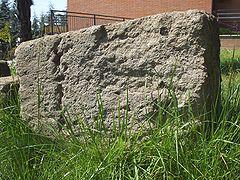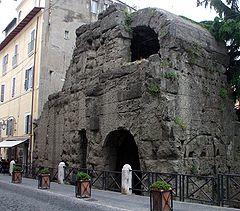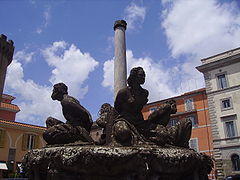
An ashlar block of Peperino dating from the Roman times

The 'Porta Pretoria' in Albano Laziale, Italy. A clear example of the durability and grey surface of Peperino

A fountain sculpted out of Peperino, in Marino, Italy
Peperino is an Italian name applied to a brown or grey volcanic tuff, containing fragments of basalt and limestone, with disseminated crystals of augite, mica, magnetite, leucite, and other similar minerals. The typical peperino occurs in the Alban Hills and in Soriano nel Cimino, near Rome, and was used by the ancients, under the name of lapis albanus, as a building stone and for the basins of fountains.
Other tuffs and conglomerates in Auvergne and elsewhere are also called peperino. The name originally referred to the dark-colored inclusions, suggestive of pepper-corns. In English the word has sometimes been written "peperine".
References
 This article incorporates text from a publication now in the public domain: Chisholm, Hugh, ed. (1911). "Peperino". Encyclopædia Britannica. 21 (11th ed.). Cambridge University Press. p. 127.
This article incorporates text from a publication now in the public domain: Chisholm, Hugh, ed. (1911). "Peperino". Encyclopædia Britannica. 21 (11th ed.). Cambridge University Press. p. 127.